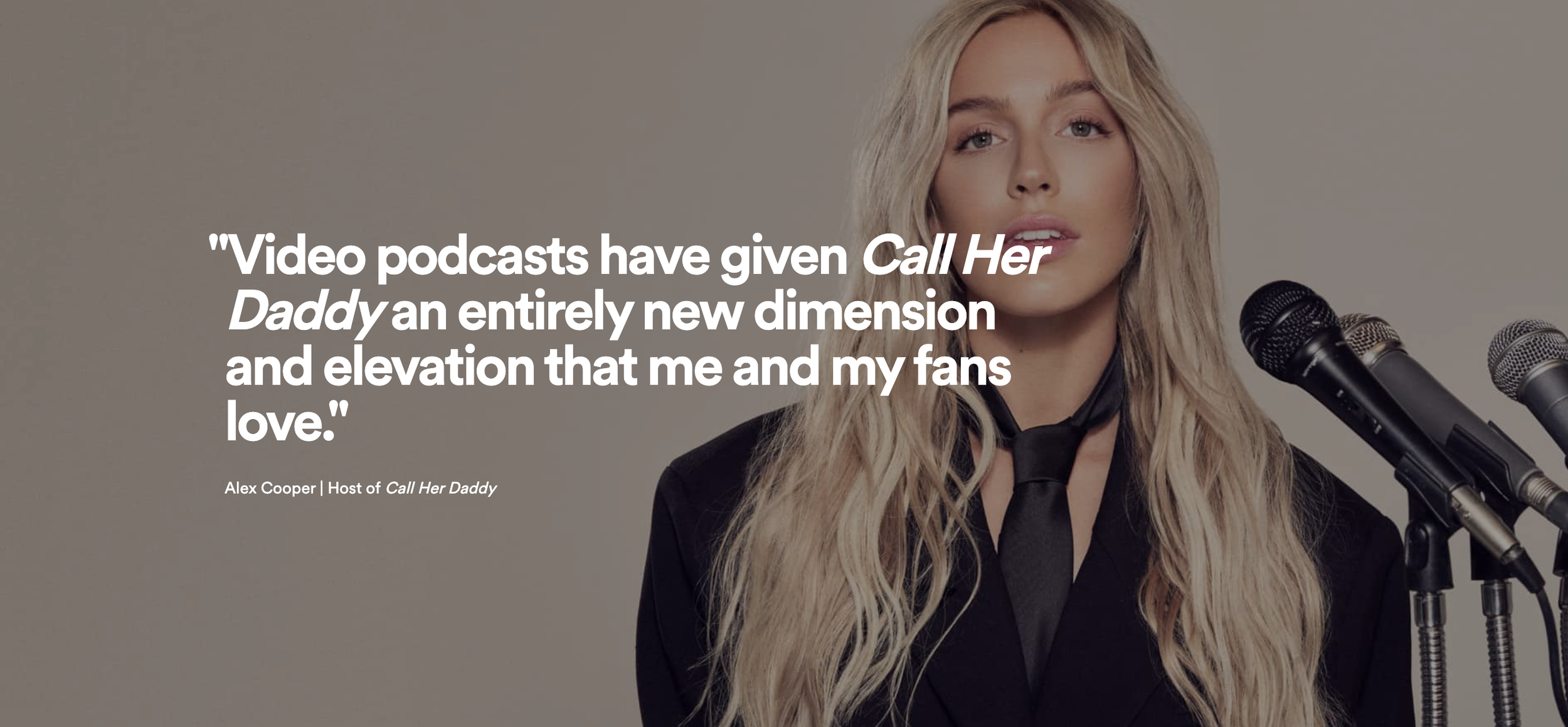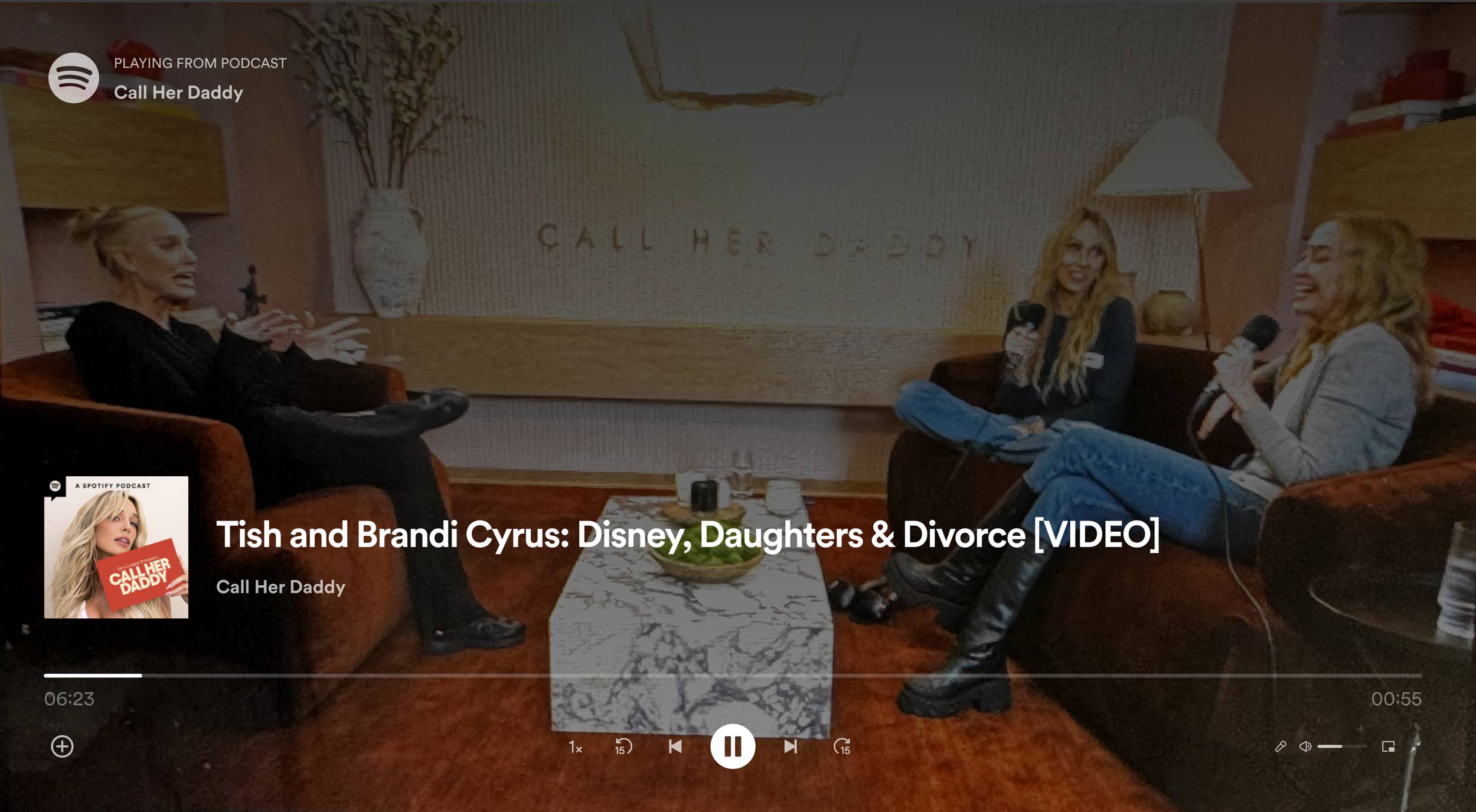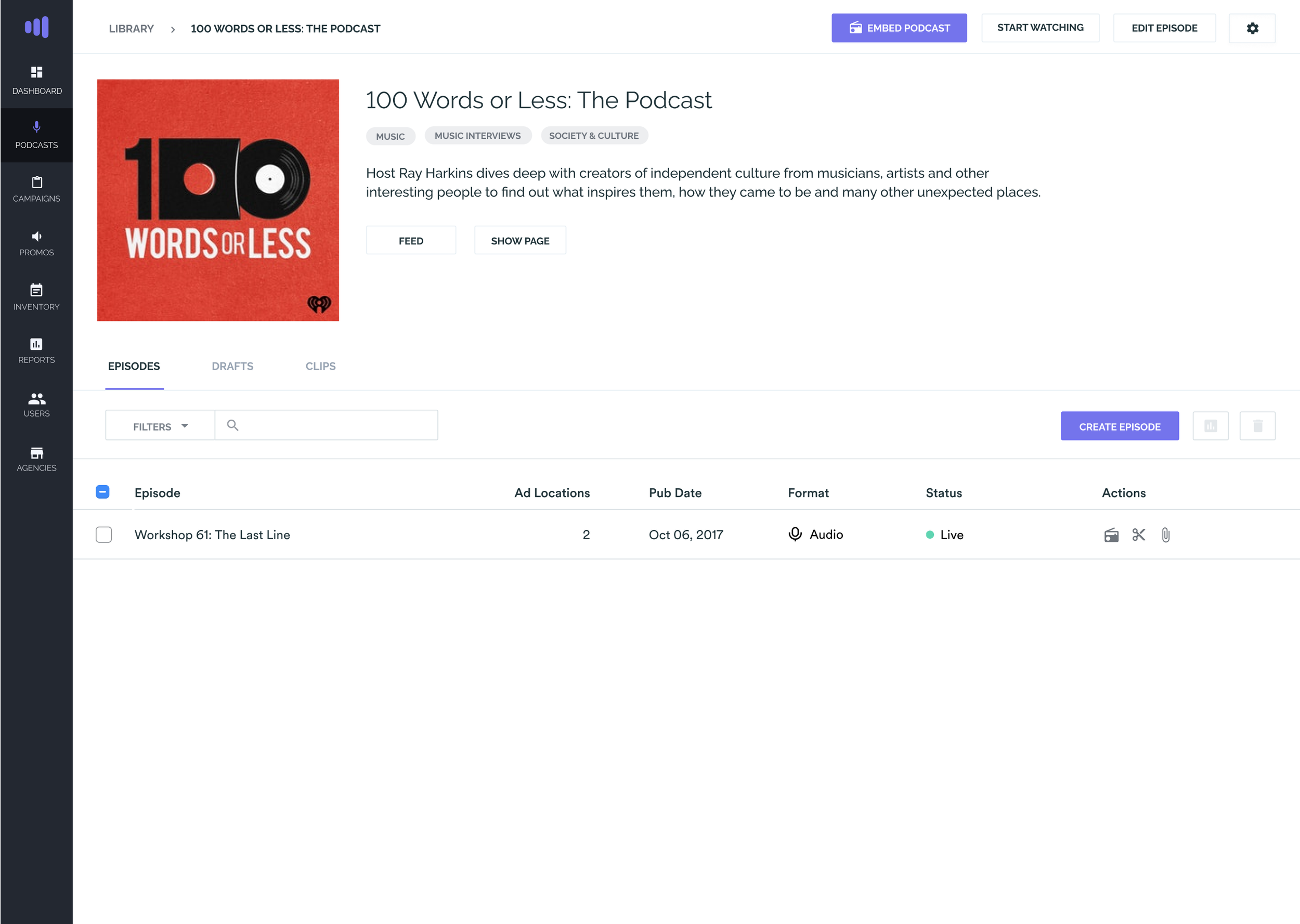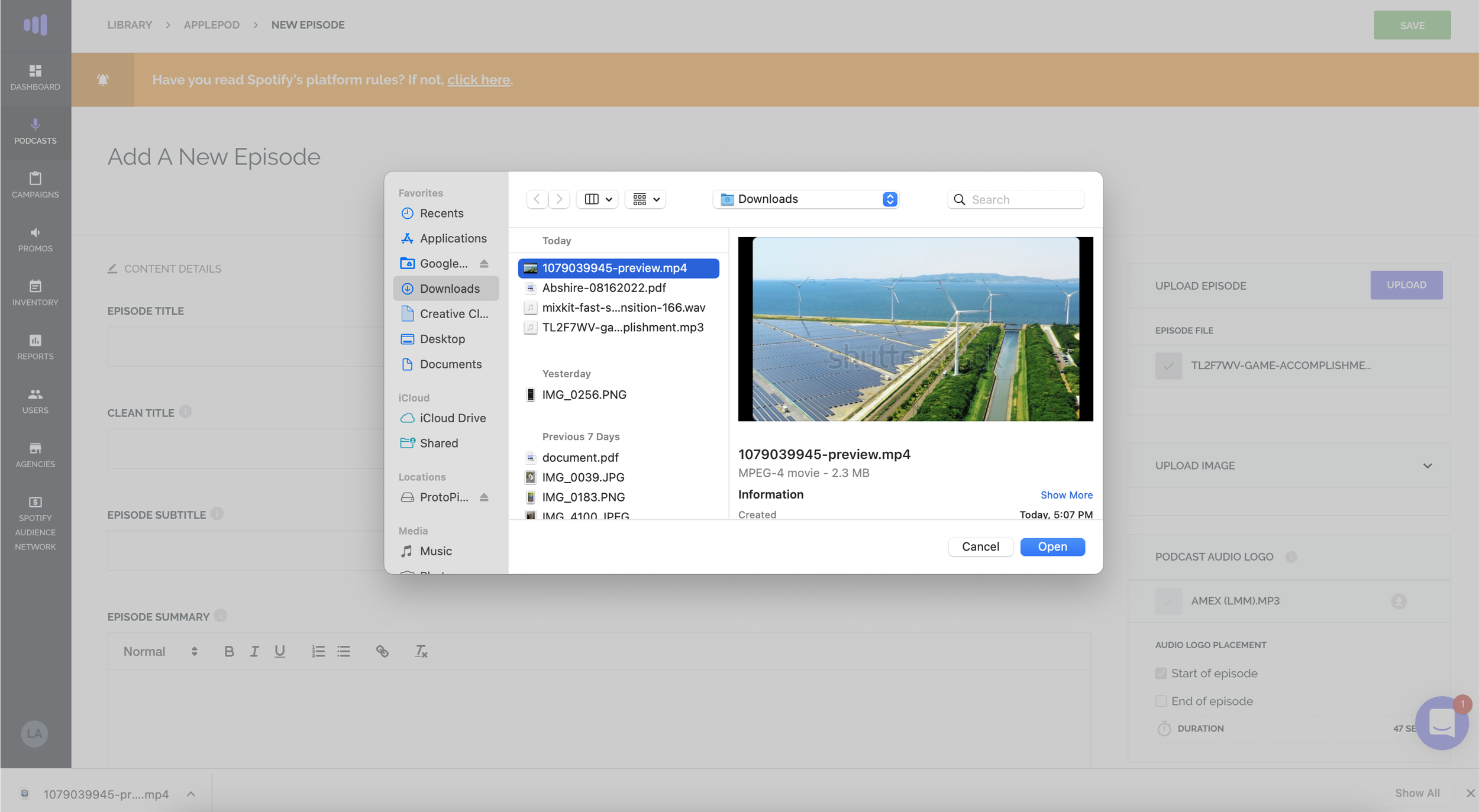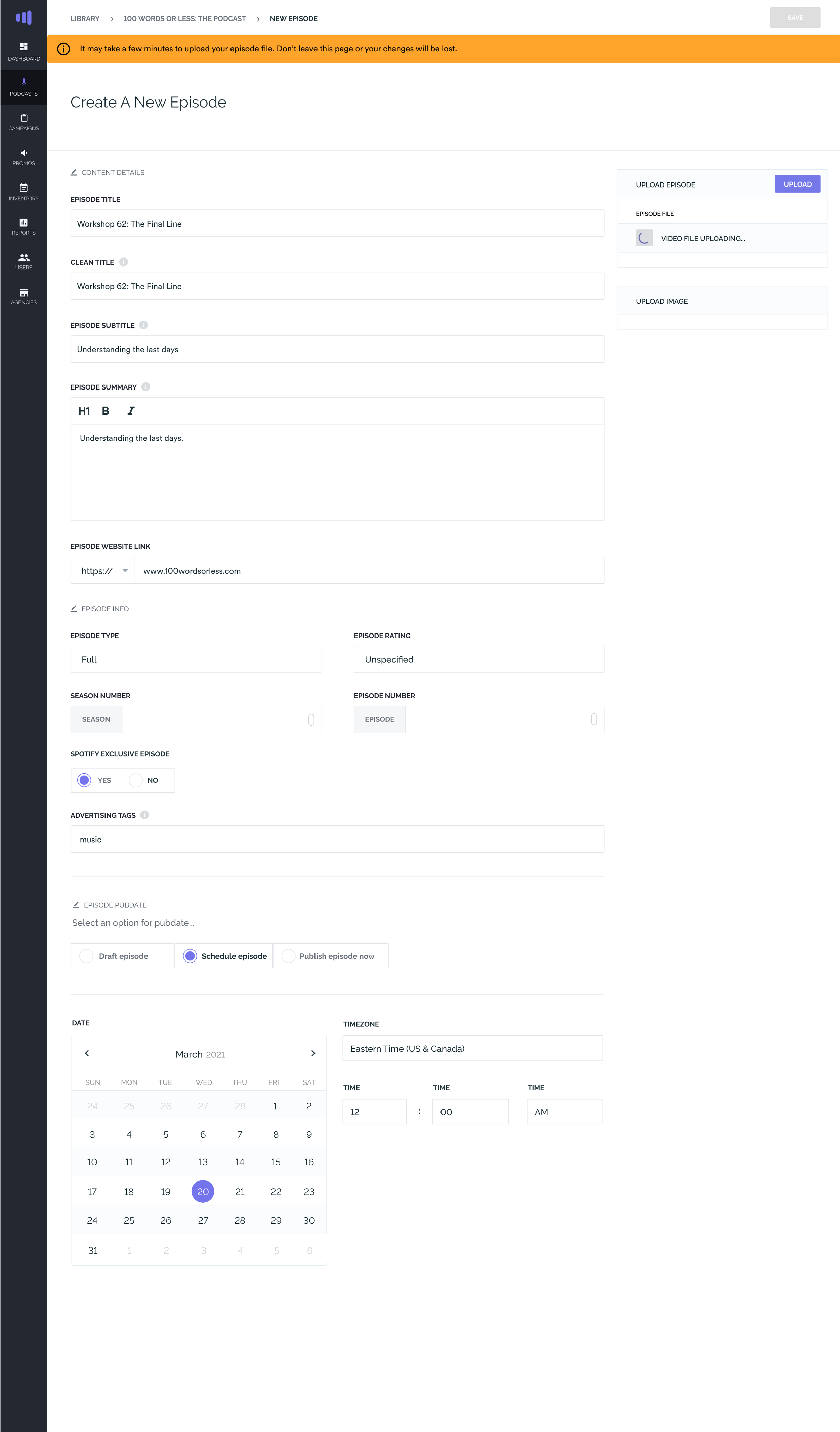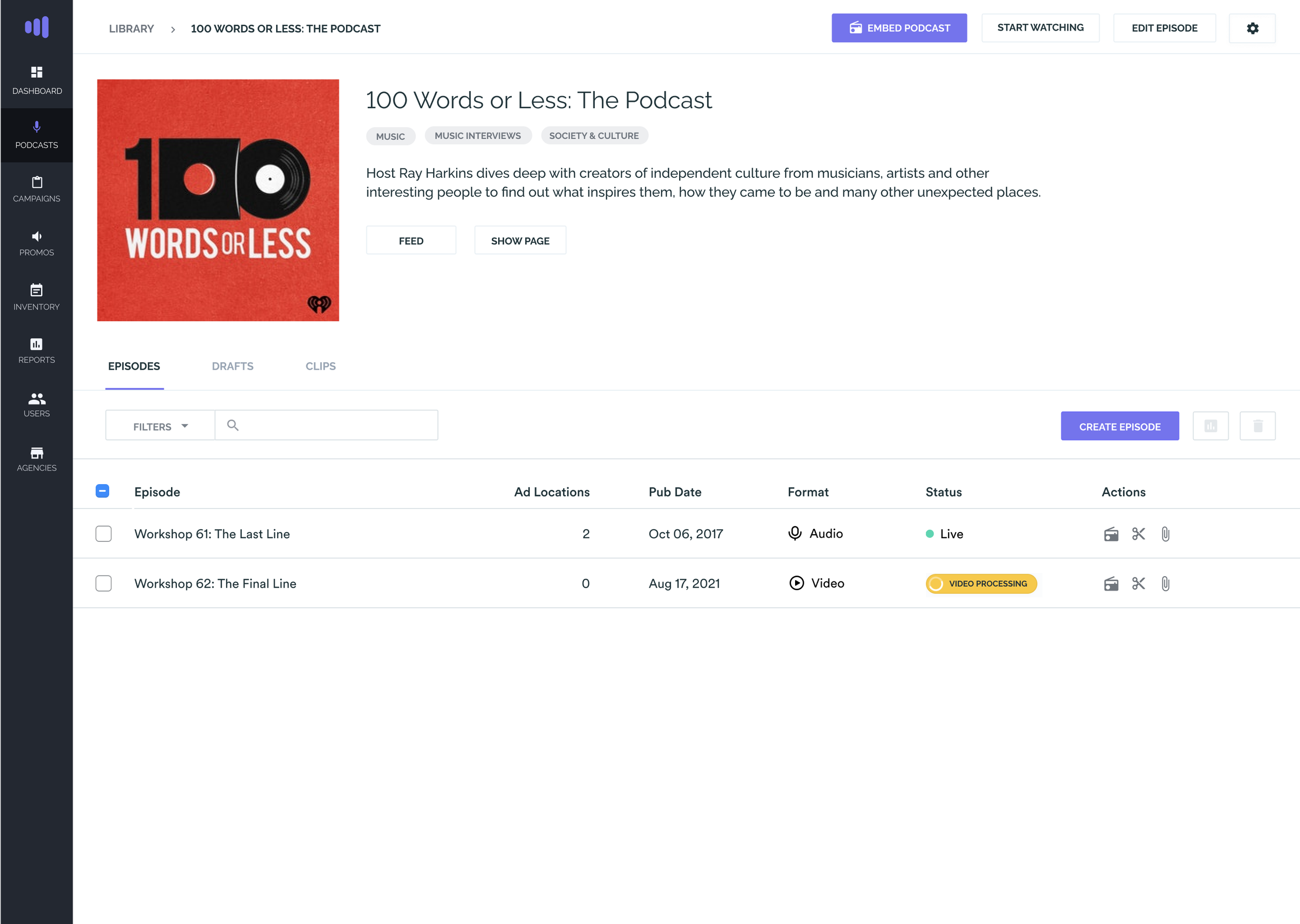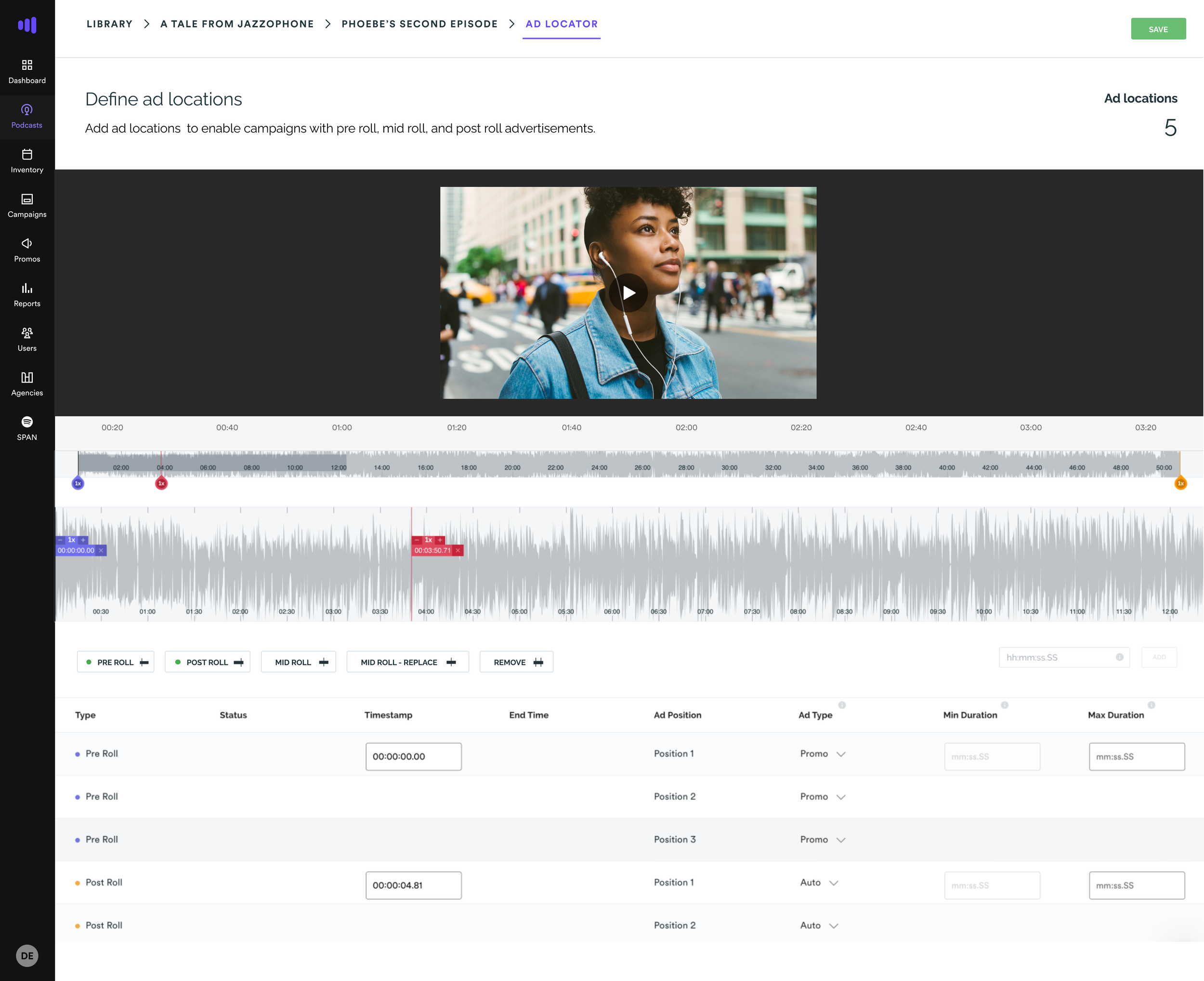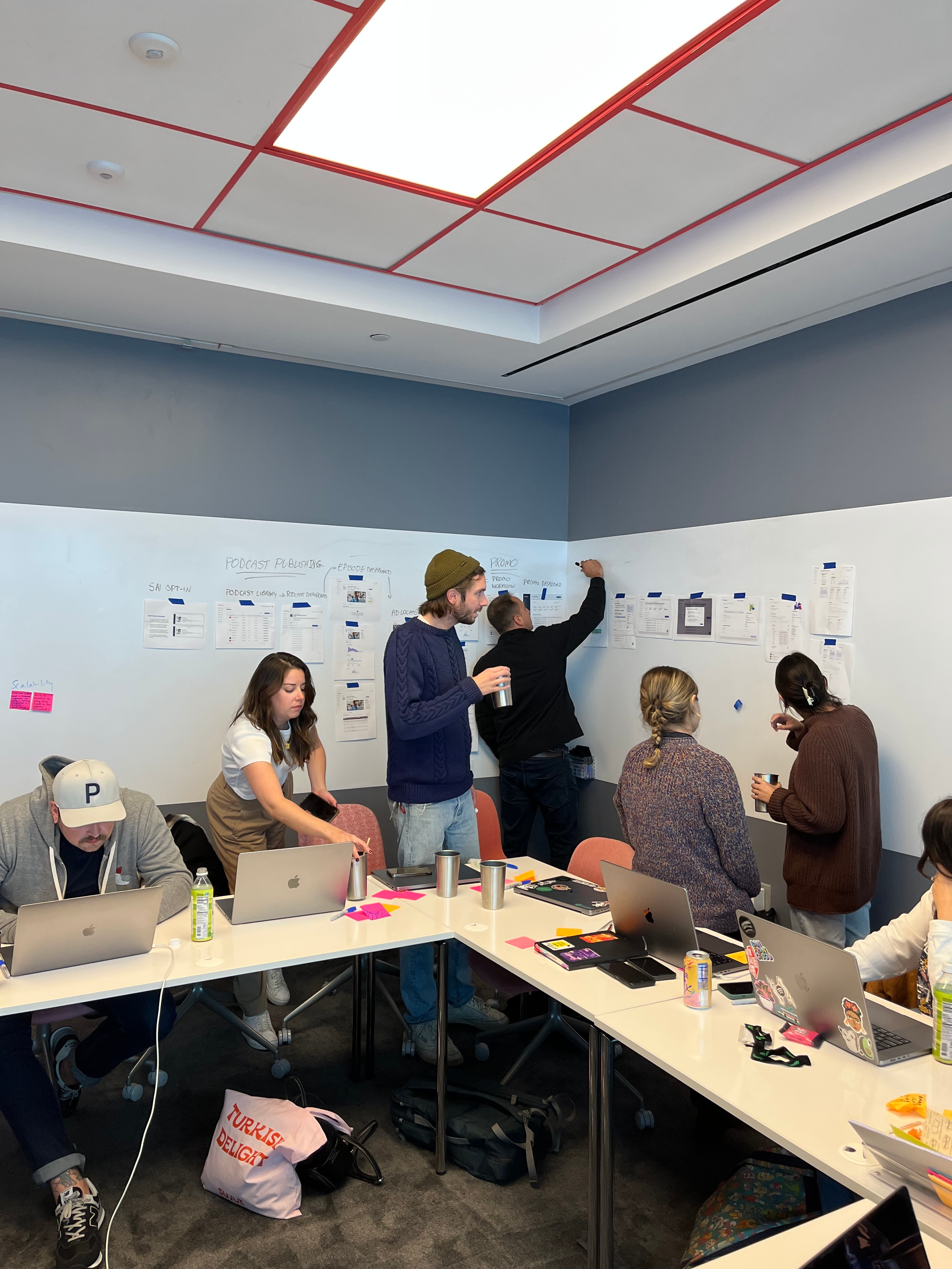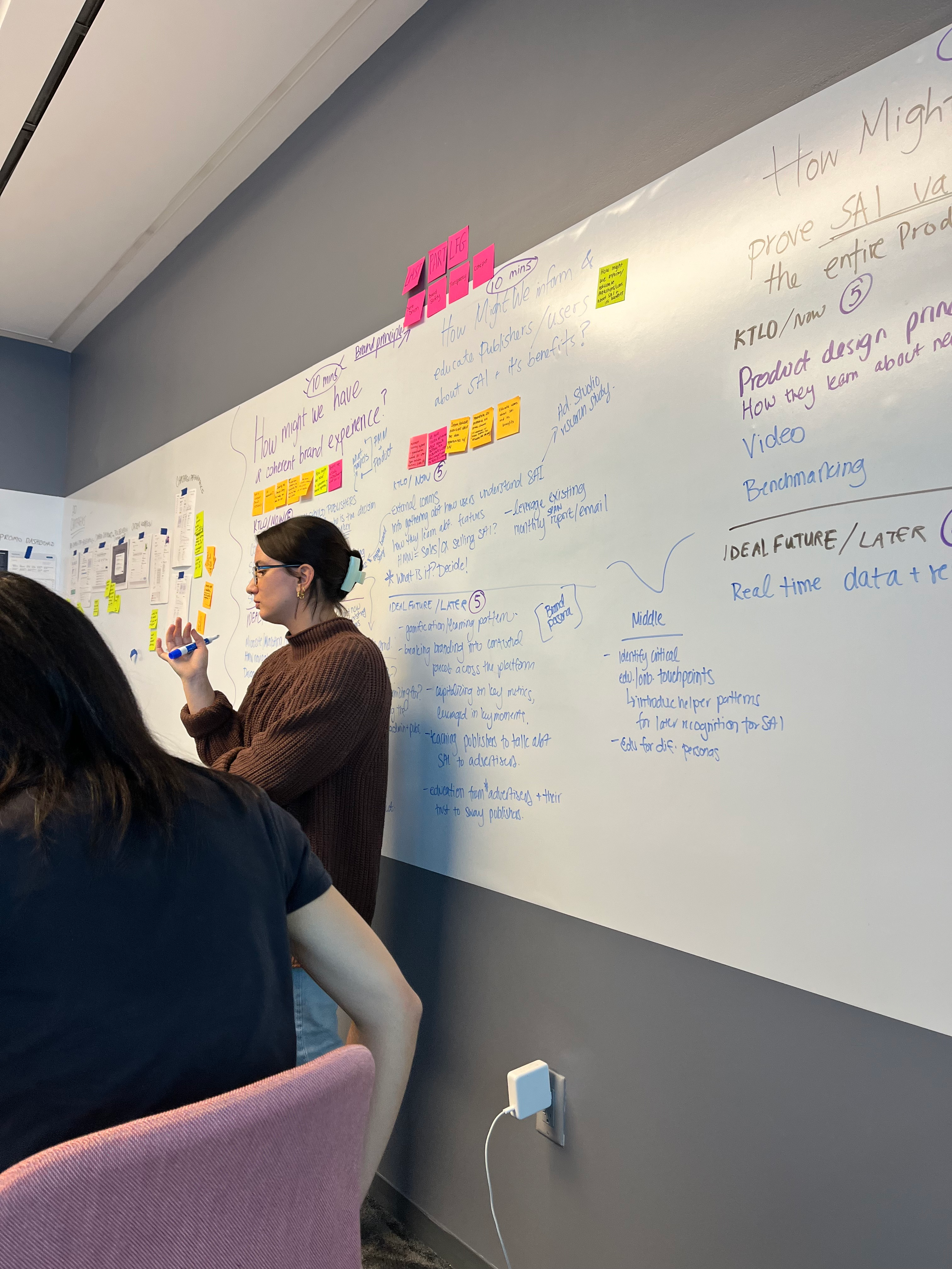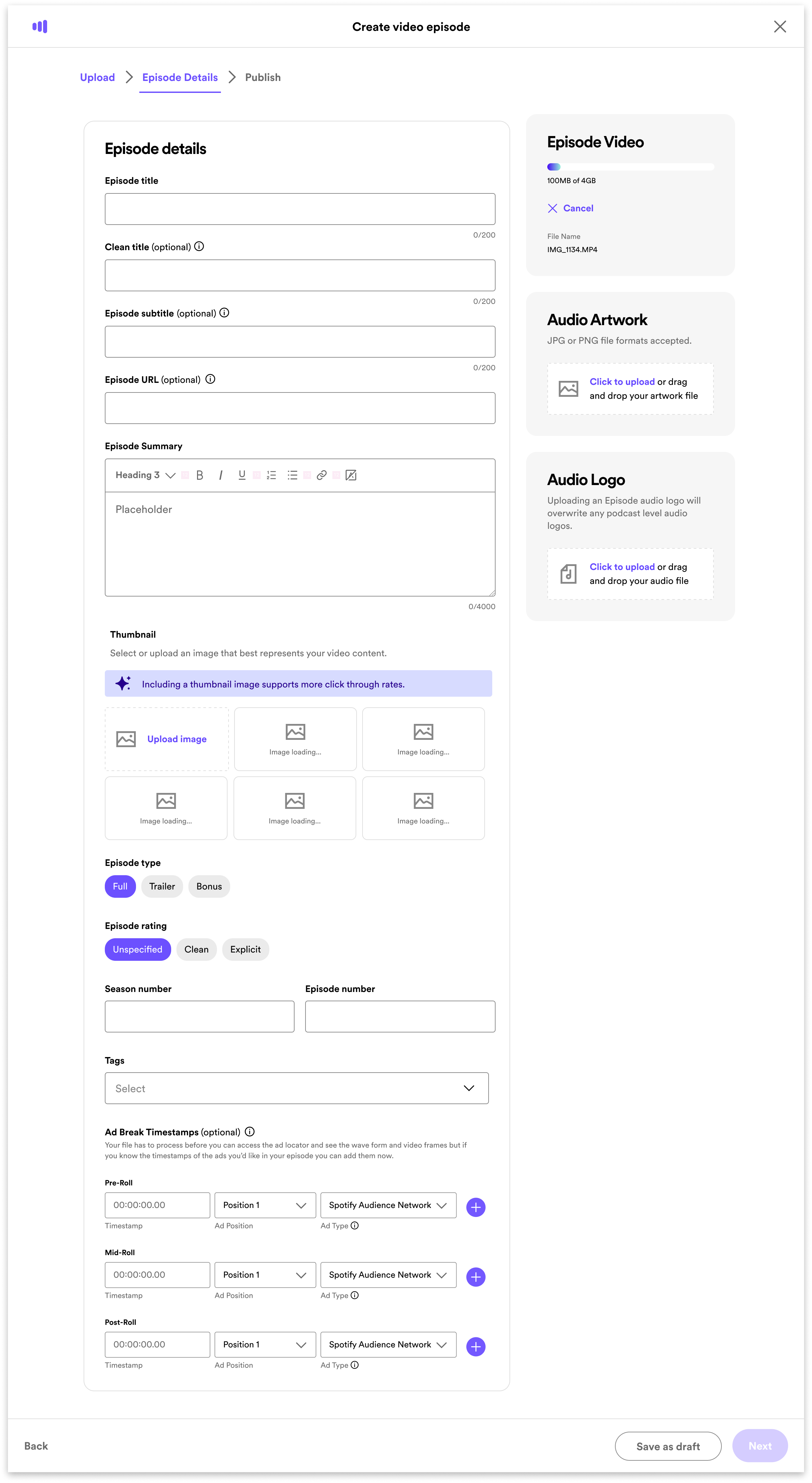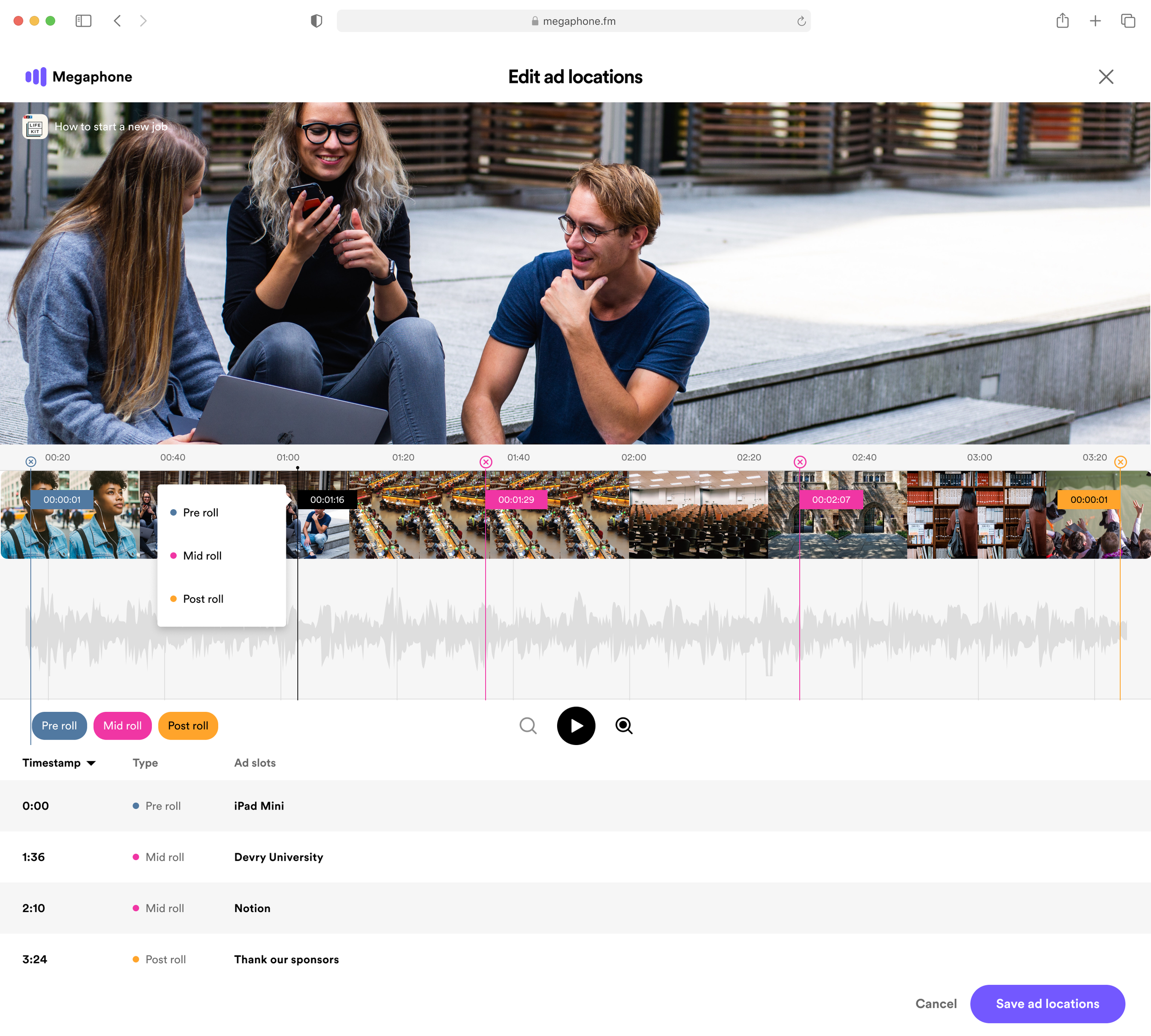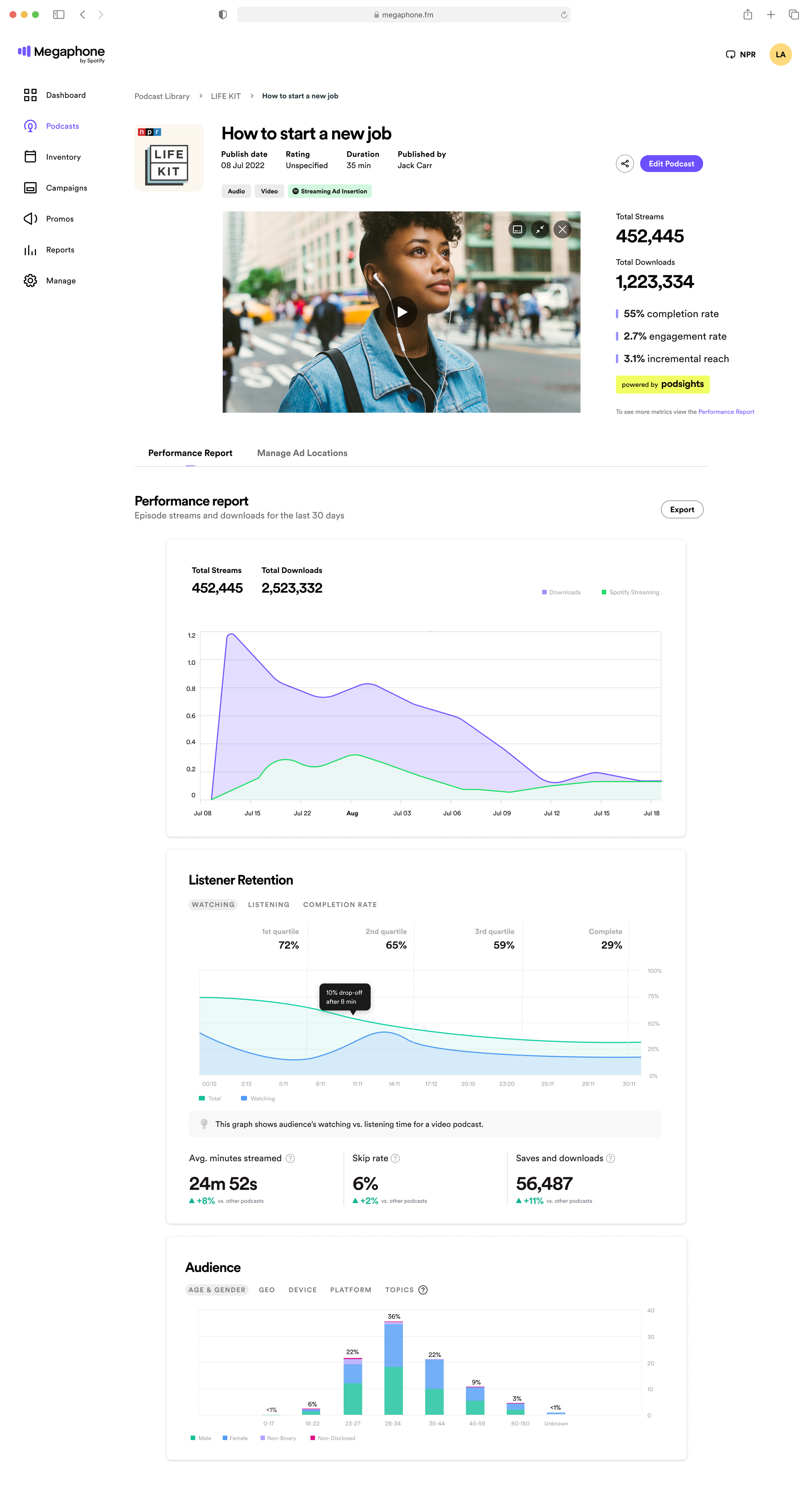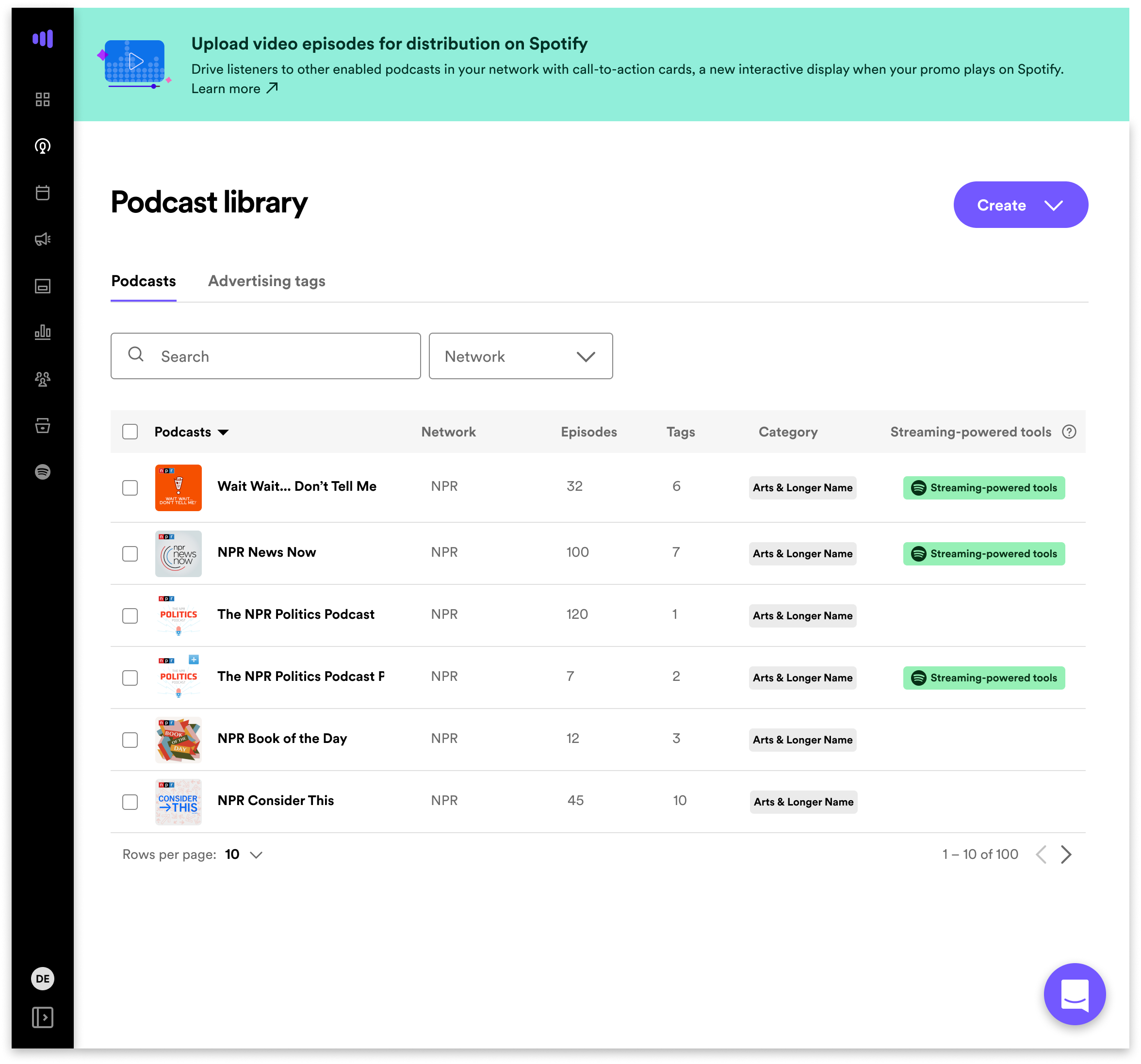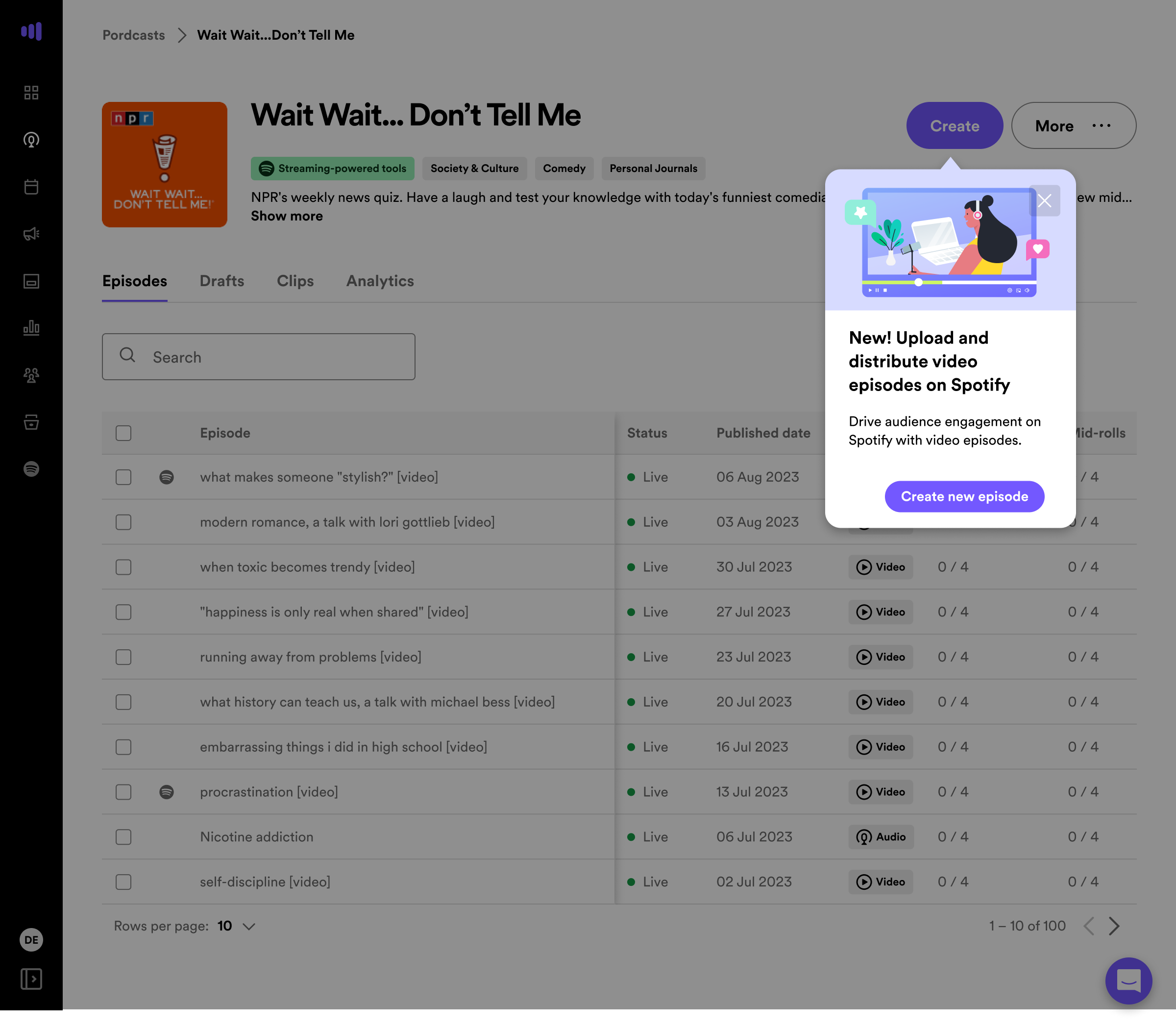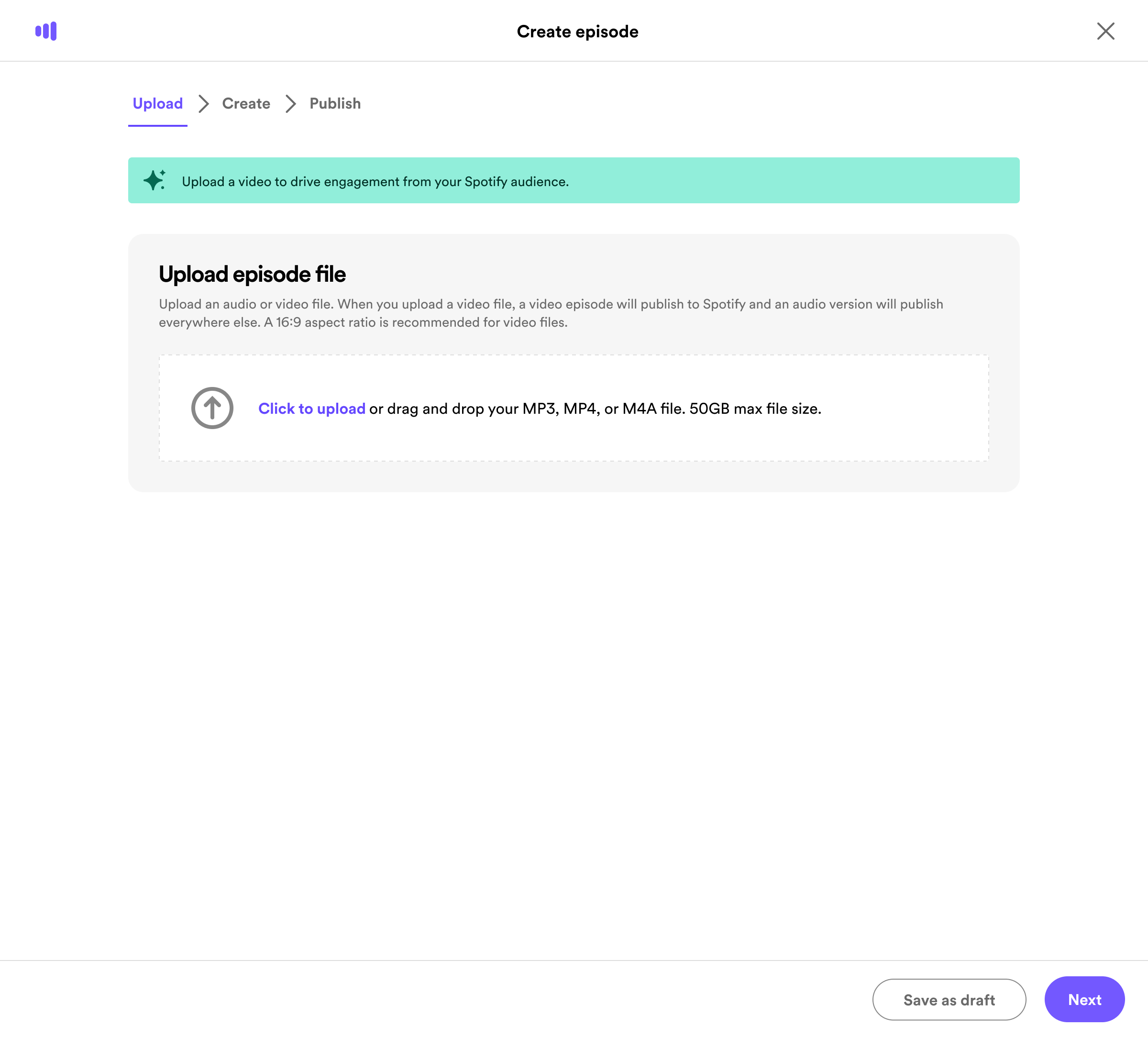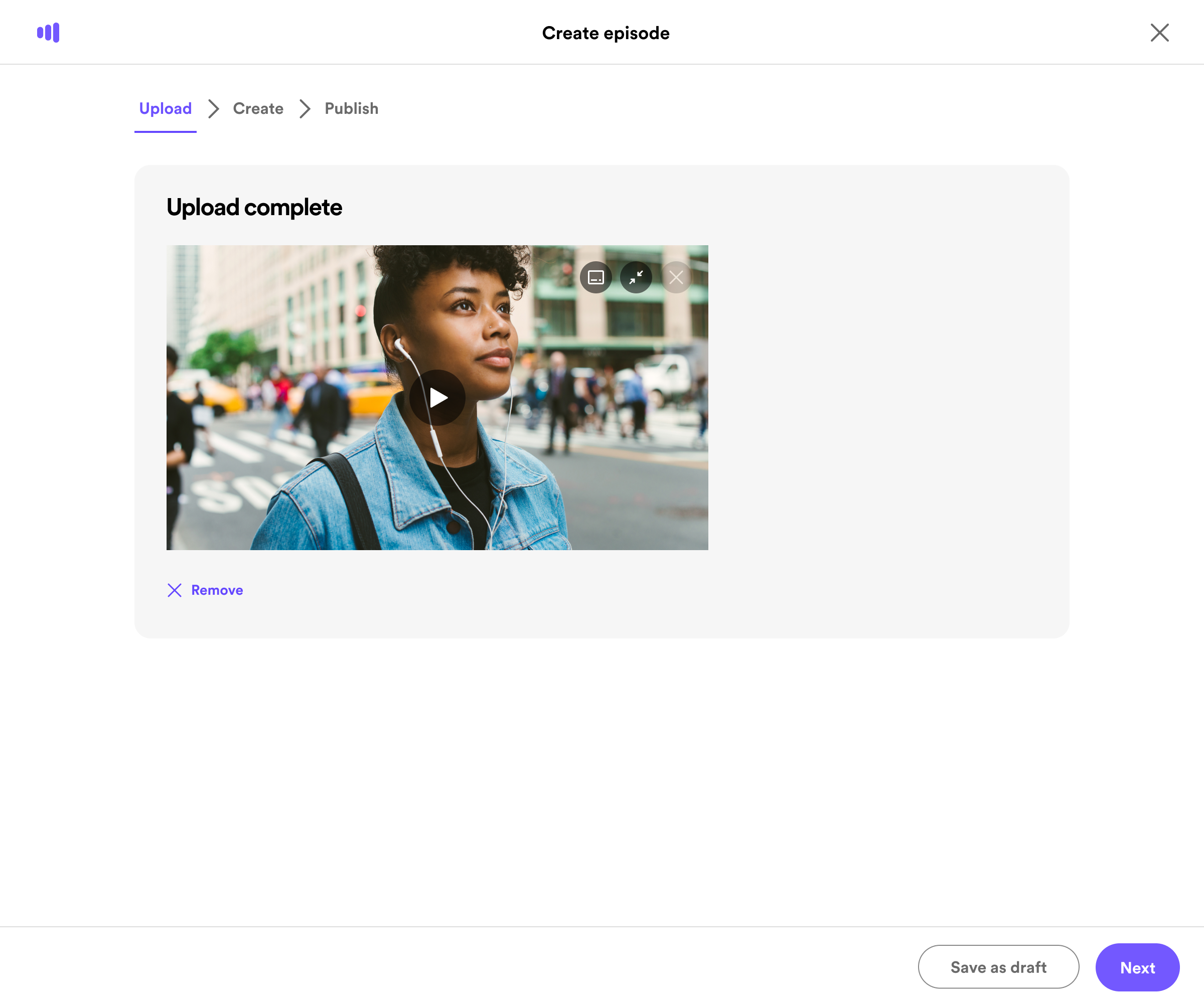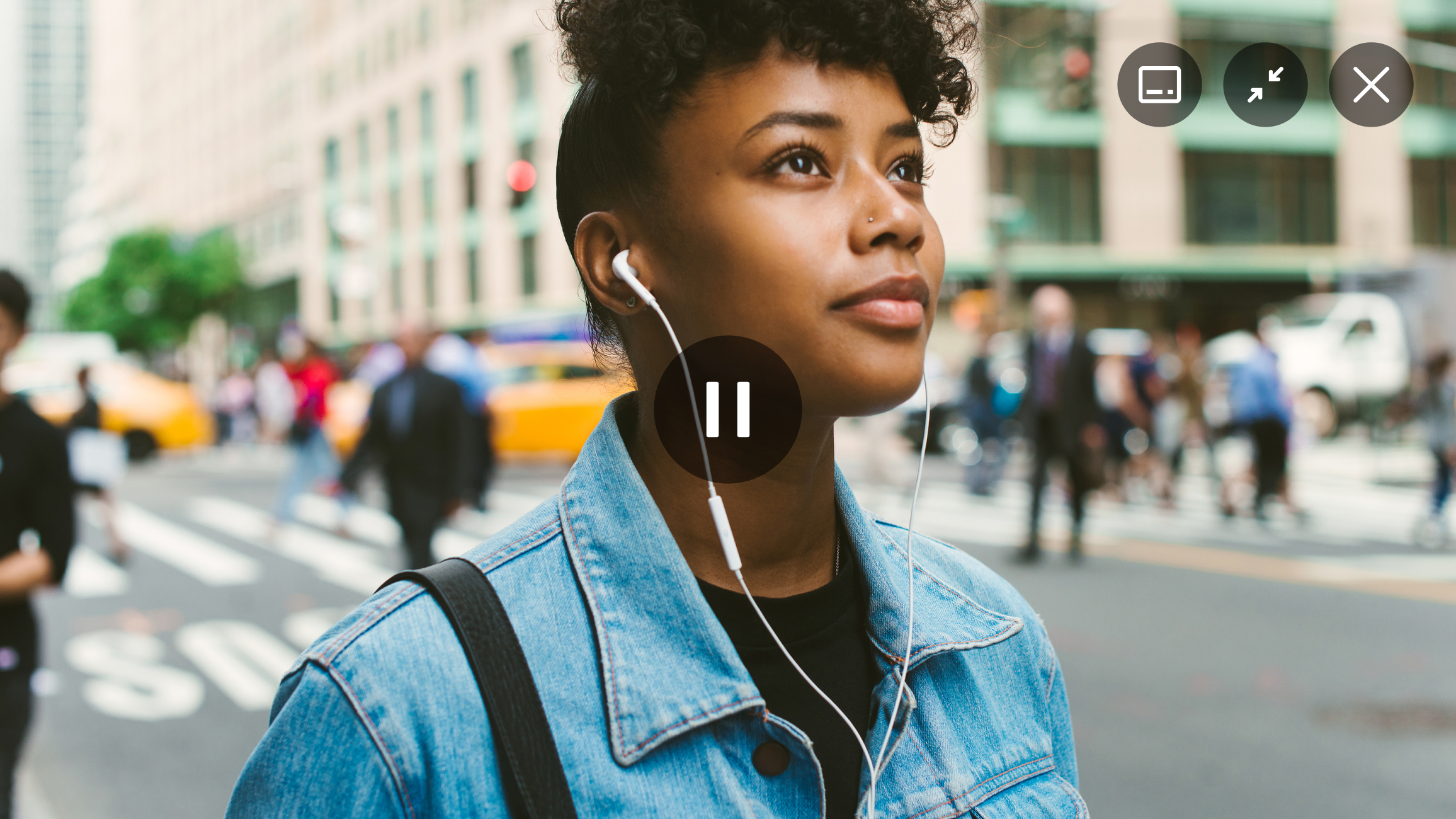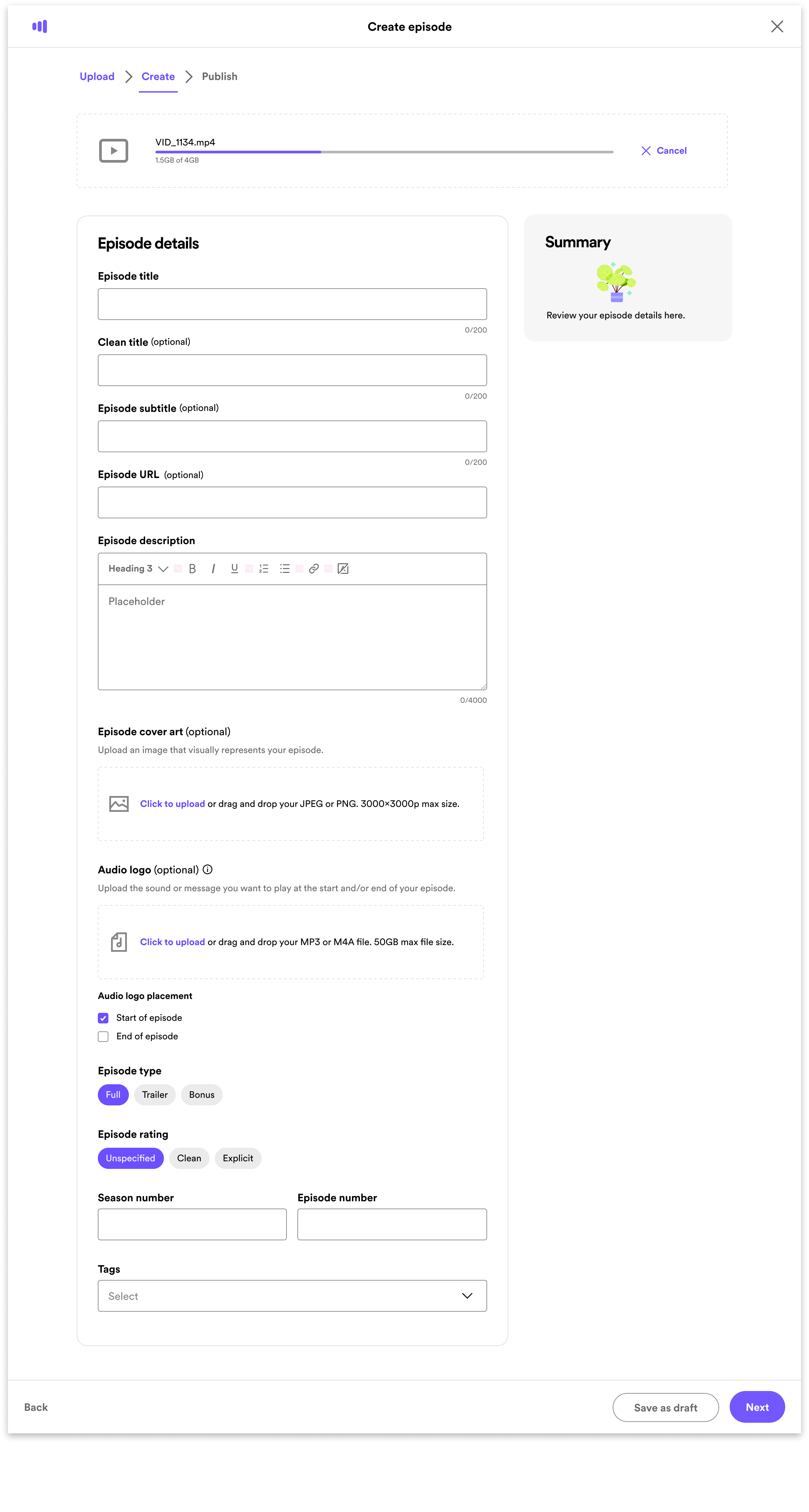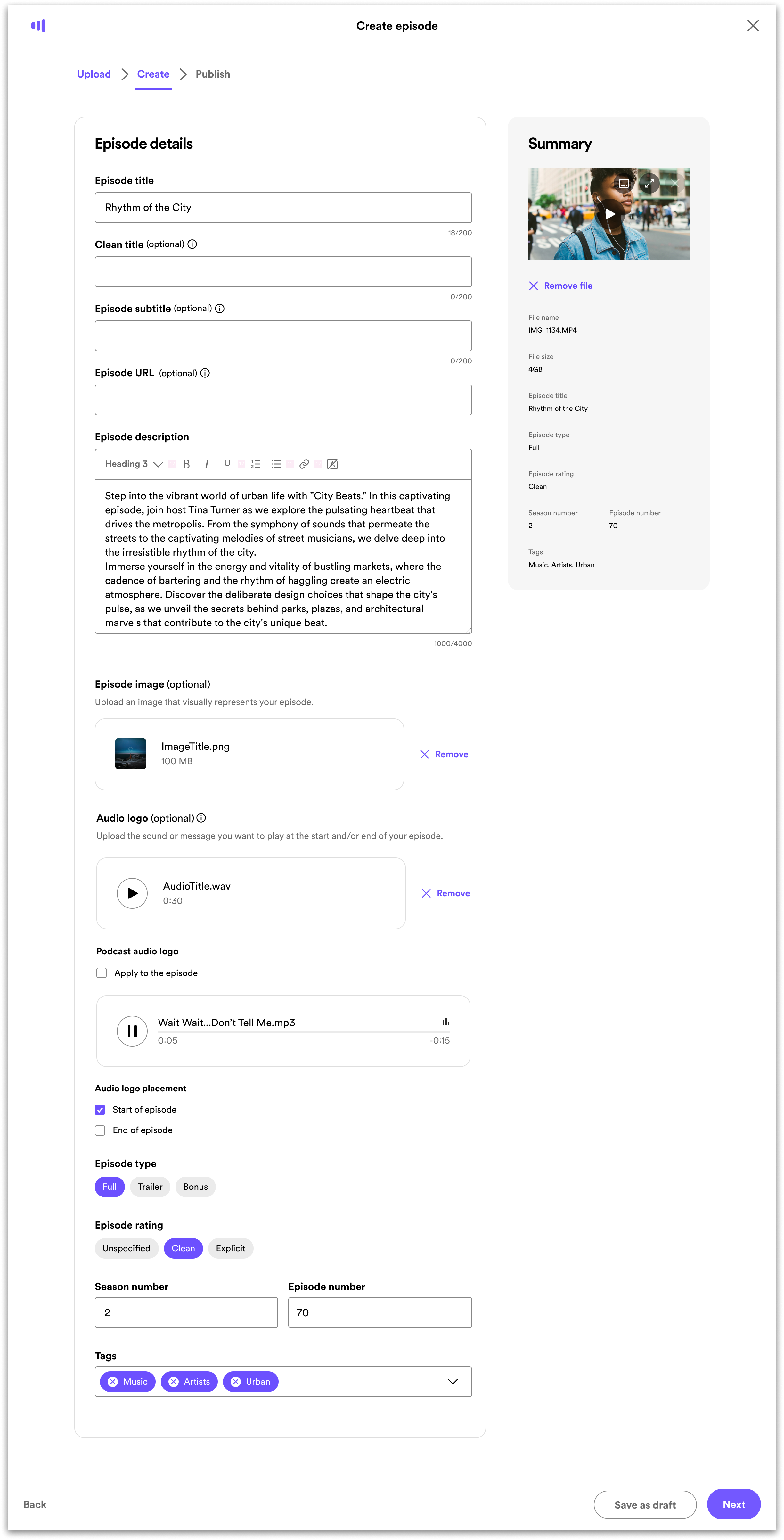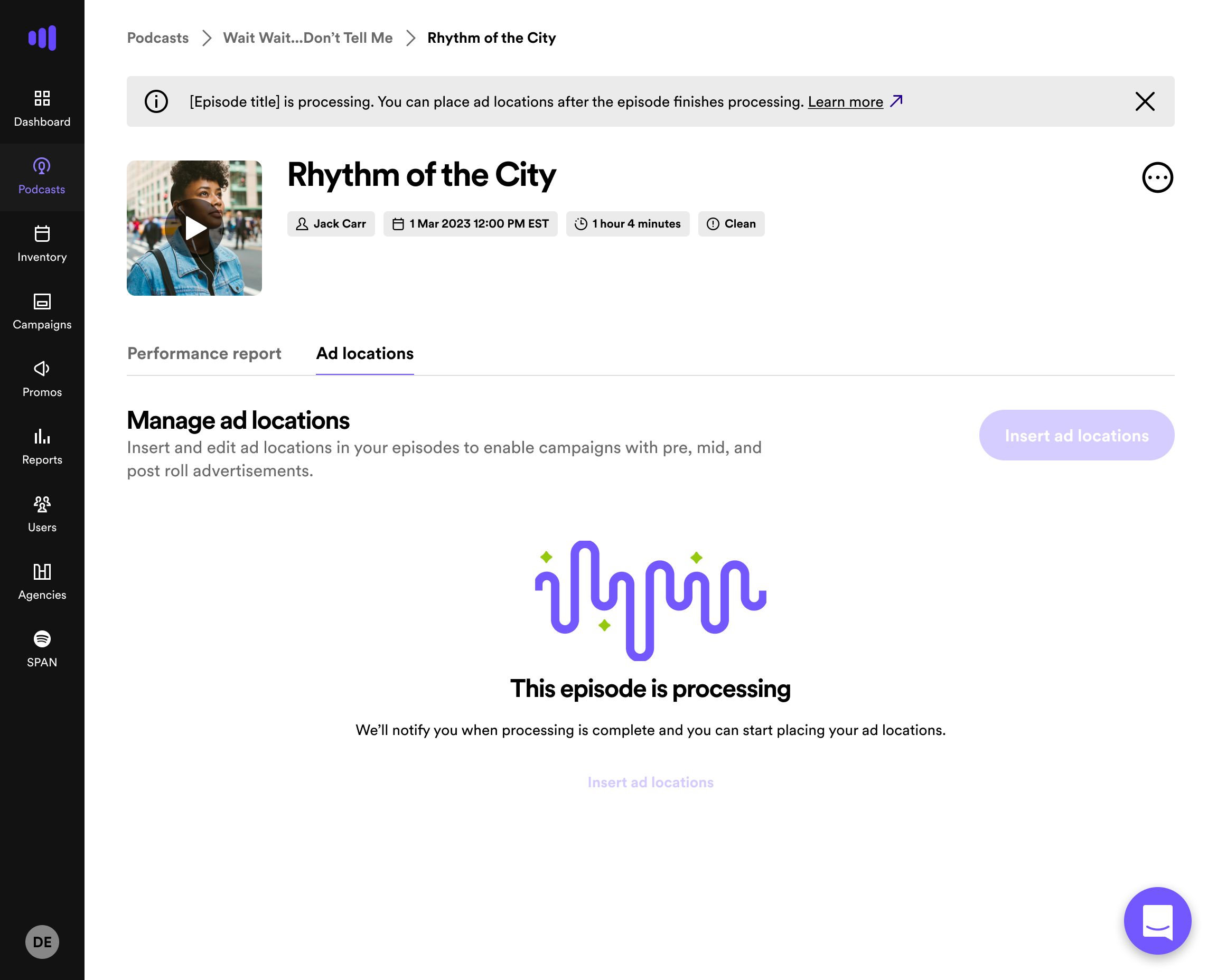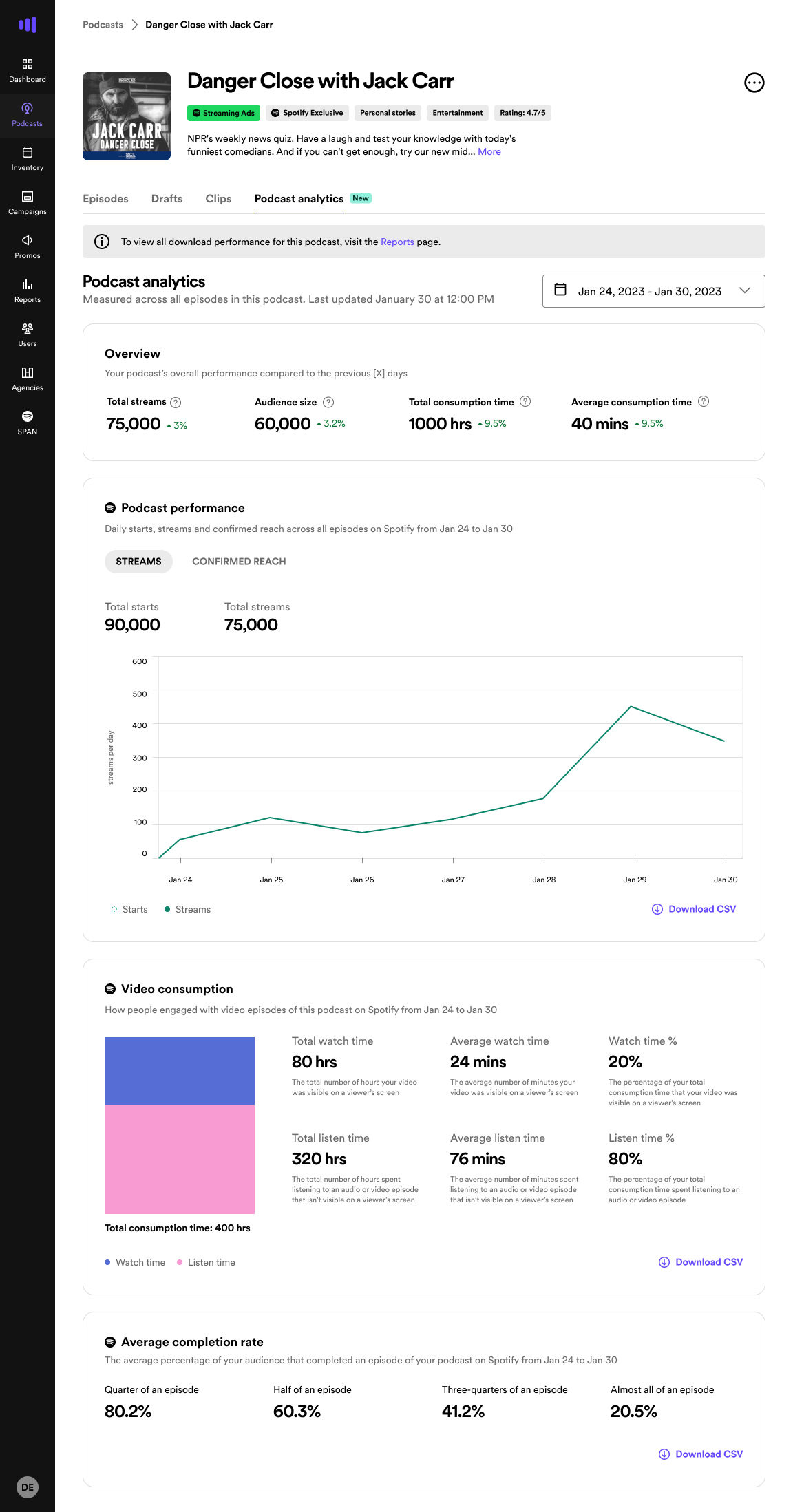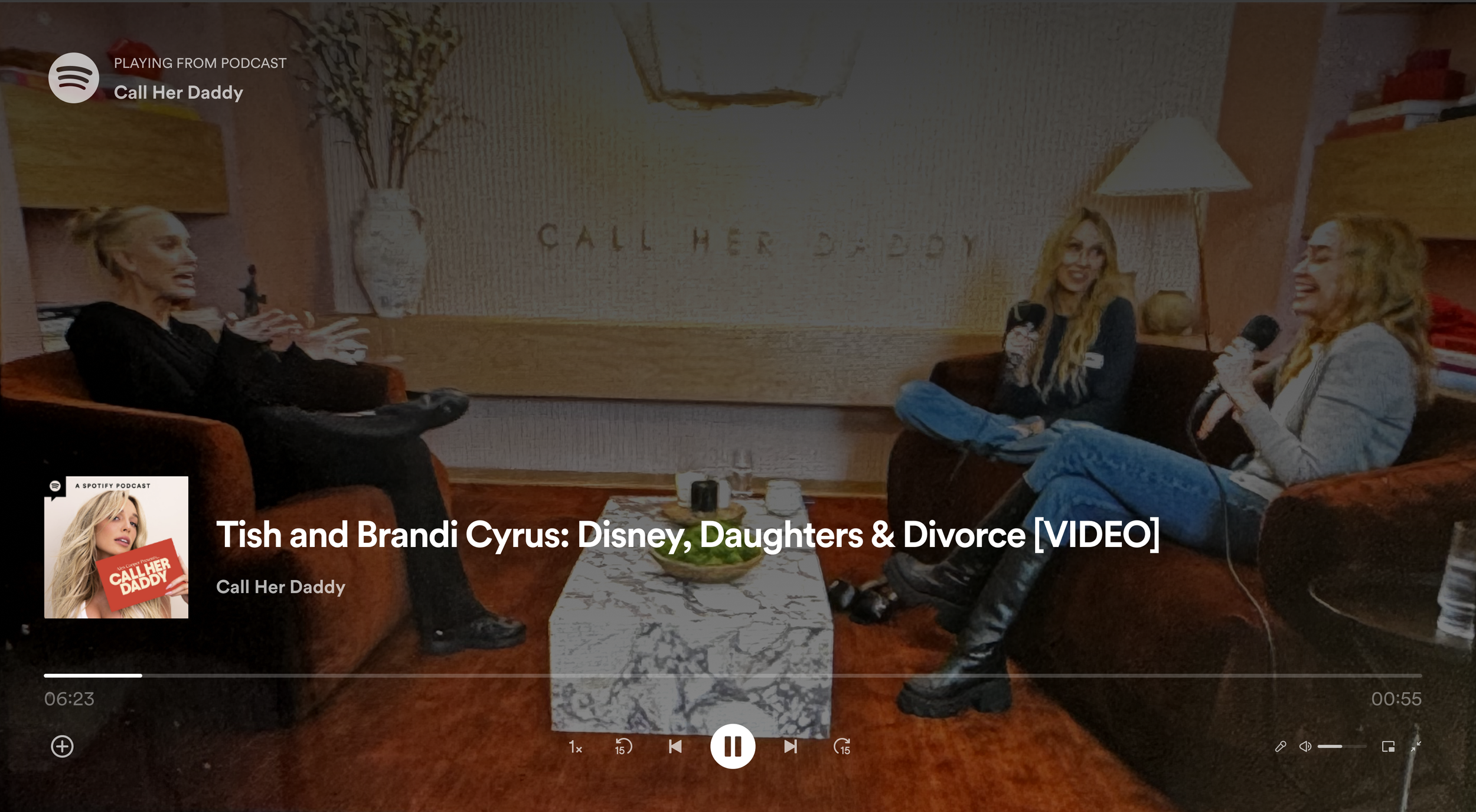Spotify Video Podcasts
The Spotify video podcast product allows users to publish and monetize video podcast episodes on Spotify directly through the Spotify-owned Megaphone platform.
Megaphone is an entire podcast toolkit that allows you to publish anywhere, monetize your content, and grow your audience, all with a single podcasting suite backed by the power of Spotify.
-
Product Design Lead
-
Strategic vision
Product design
Project management -
Product Management
Content Design
Engineering
Marketing
Customer Success
User Research
Data Insights
Context & Business Problem
Video is a key feature in our path to overcoming the limited streaming-powered tools scale. Spotify wanted to grow streaming-powered tools engagement and also meet current podcast publisher demands by adding video podcast publishing on Spotify-owned Megaphone, video episodes available to stream only on Spotify. (The Megaphone platform is a comprehensive publishing and advertising tool for the podcast industry.)
User Problem
Listeners are more likely to engage video podcast episodes over audio. Video increases podcast streaming impressions by 69% and enables publishers to reach a wider audience. Publishers have the desire to grow their podcast audience and provide their advertisers with more appealing product advertising opportunities.

Challenges
Introducing new technology
Video podcast episodes were a new feature running on new technology (streaming ads) which meant that in order for publishers to access this new feature they would have to enable Streaming-powered tools that leverages streaming technology over downloads. DAI (downloaded-ad insertion) often over-estimates impressions whereas SAI (streaming-ad insertion) delivers real-time, accurate impressions. This meant publishers' performance metrics would seemingly dip while transitioning to SAI, causing frustration and doubt.
A top 10 Bet at Spotify
Streaming-powered tools was a top 10 priority for the whole Spotify org, Video episode podcasts was a primary product apart of this product suite. While this was an amazing opportunity it also meant a level of external communication outside the working group was required consistently and widespread. On the flip-side, we got a unique and invaluable opportunity to present to C-level leaders and get rapid feedback for iteration.
Collaborating across multiple teams and cross-functional partners
Video podcast episodes apart of the Streaming-powered tools product was a major undertaking that spanned across almost every squad on Megaphone. I was tasked with leading this initiative from a design standpoint and delivering experiences across the enablement of SAI and video podcast episodes on the platform. While leading the collaboration across the entire delivery of this workstream. We also forged new relationships and collaborated with many cross-functional partners such as marketing, user research, engineering, and product in order to gather the right knowledge and expertise.
Handling technical limitations
Launching a new product offering that runs on new technology is no easy feat. Our engineers were working overtime to meet ever-changing feature requirements. At times, the product team reduced certain feature functionality to meet deadlines. These cutbacks often impacted the overall integrity of design’s vision.
Alpha Experience
The alpha video publishing experience was to use the current experience for audio episode publishing on Megaphone without a needed redesign to increase speed to release and limit engineering workload. This experience was released to a small subset of the user base as a test group and included research touch points directly with users.
Key features of the alpha were to allow the user to upload either a video or audio episode file. Allow the user to see the video when inserting ads into their episode. Reporting and analytics were bespoke and sent to publishers’ inboxes via email.
Problems with this included:
♦️ No onboarding and education on the net-new video feature.
♦️ Without CX introduction to the alpha video experience there was no organic self-service user discovery.
♦️ Publishers expected to see video streaming analytics in the app.
Old Megaphone UI - Podcast Detail Page
Old Megaphone UI - Episode Creation Page
Old Megaphone UI - Media Selection
Old Megaphone UI - File Selection
Old Megaphone UI - File Uploading in-progress
Old Megaphone UI - File Upload Complete
Old Megaphone UI - Episode Processing
Old Megaphone UI - Ad locator + Video
Opportunities
I facilitated multiple x-functional workshops and a couple of design sprints to identify our key opportunities, the challenges we will face and how we could overcome them, our design approach, the full scope end-to-end of video podcast episodes, and a glance into the future. Below are the opportunities we distilled, the highlighted HMW are opportunities we pursued in the first iteration.
How might we surface more data to prove the benefits of video and streaming-powered tools?
How might we onboard publishers to the new video episode feature?
How might we be transparent to users the statuses of their video episodes?
How might we streamline the process of podcast video publishing to combat time-consuming and manual complexity perceptions?
How might we make the ad slot location task more evident as a mandatory step after video processing?
How might we show the user the audience growth garnered via the video episode?
How might we guide publishers on how to strategically use video as a tool for growth and monetization?
How might we allow users to multi-task while uploading video episodes?
How might we give users actionable insights on their video streaming reporting?
Hypothesis
Belief 1
If we want to be the place where Users come for podcasts, we believe we should have both Audio and Video formats
Belief 2
We believe Video will bring Users closer to the Creators
Belief 3
We believe Video will increase foreground consumption and new monetization opportunities
Gap in the Market
Users currently see YouTube as a primary source for podcast video consumption. However, since Spotify has the dominant share of Podcast listeners by adding video podcasts we have an opportunity to increase podcast market dominance.
Design Approach
Provide Guidance
At every step of the way we should be guiding the user towards the most positive outcome for their business, helping them understand the process and the potential outcomes.
Be Flexible
Not all users have the same needs and we are aware of that, our designs should reflect flexibility empowerment and control for our users.
Make it easy
Based on research there has been feedback from users that the Megaphone platform can be difficult, let’s increase ease of use to allow for less barrier to entry.

Conceptual Development
After identifying our opportunities we iterated upon what could be a potential solution for the video episode creation flow. I did this work in collaboration with a content designer, research, engineering, and product management.
Early Iterations
After brainstorming on potential user flows I designed some potential high fidelity mocks in order to share concepts with leadership, other teams, and users.
Research
Goal:
The research goal was to understand publishers’ Megaphone video alpha/beta experience, video data needs + perceptions of the video reporting surface.
Methodology:
9 participants
60-minute in-depth interviews consisted of structured guided interviews and usability concept testing
-
The video creation flow feels intuitive & consistent with the audio podcast experience driving satisfaction. It meets a variety of publishers’ goals; increases audience reach, diversifies video platforms beyond Youtube, and meets listeners expectations.
Areas for Improvement:
1. Give more affordance to status of video upload.2. Allow autosave of publishing content.
3. Allow for batch uploads
-
Perceived as informative but lacked detail to be actionable
Presentation of the data does not meet clarity needs, what is aggregative (show vs. episode) data, and clarify value of consumption rate chart

Final Design Snapshot
After rounds of research, user feedback, and technical scoping, we landed on a solution for video episode uploading and reporting on the Megaphone platform. This is a V1, later iterations will include bulk upload and management.
Megaphone Podcast Library - Video Ep Banner
Video Eps pop-up
Video EPS Creation - Upload
Video EPS Creation - File Selector
Video EPS Creation - Upload in-progress
Video EPS Creation - upload complete
Full Screen Video Ep Preview
Video EPS Creation - create (content)
Video EPS Creation - Create (filled)
Video EPS Creation - Create (complete)
Video EPS Creation - Publish, Schedule
Video EPS Creation - Publish, Schedule
Video EPS Creation - Publish Now
Podcast Detail Page - Video Ep Confirmation Banner
Video EPS Creation - Missing Requirements
Episode Detail - Episode processing
Episode Detail - Episode processing complete
Episode Details - Ad locator
Ad Locator
Episode Reporting
Show Reporting
Live in Spotify
Full Video View
Podcast Video Discovery - Mobile
Video Podcast Preview - Mobile
Podcast Video Preview - Mobile
Video Podcast Episode Playing - Mobile
Video Podcast Episode Playing - Mobile Fullscreen
Prototype
Happy Path, User: Publisher
Results
LIVE - As of June ‘24
628 million+ streaming impressions
250,000 video episodes published
170M users watching video podcast episodes

